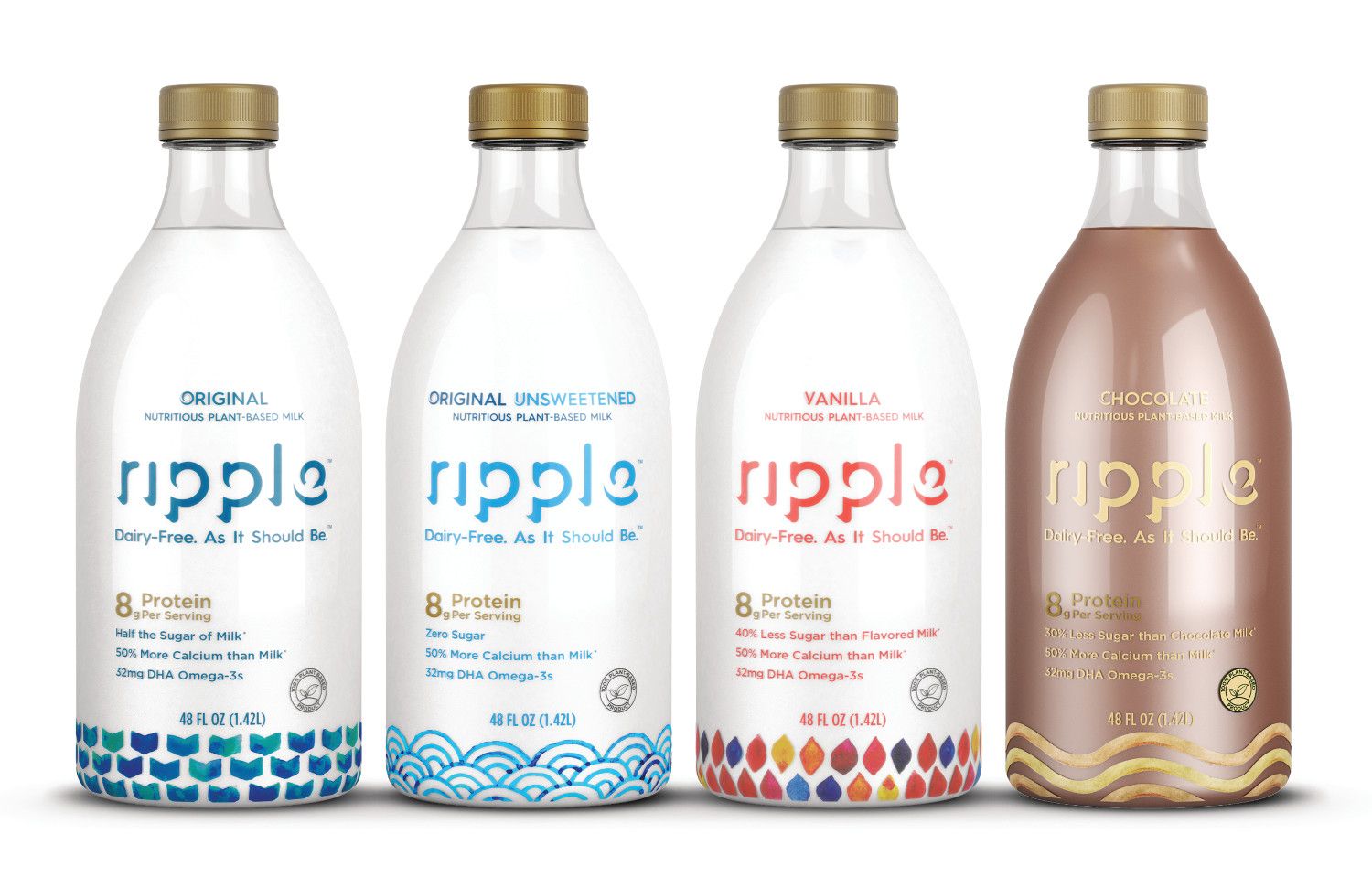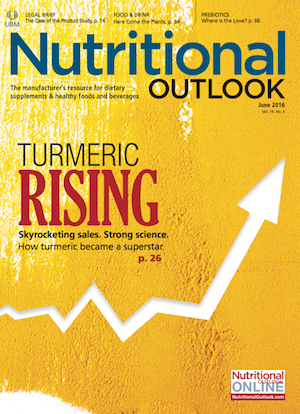Plant-Based Food and Drinks Are Scaling the Food Chain
The plant-based food and drink industry is going through one heck of a growth spurt.
Ripple is a new pea-protein milk retailing at select Whole Foods outlets nationwide and at Target stores this summer. The company says the product has the “creamy and smooth flavor that makes milk gratifying.” Most importantly, Ripple provides the same 8 g of protein per serving as dairy milk. Photo from Ripple.


Ripple is a new pea-protein milk retailing at select Whole Foods outlets nationwide and at Target stores this summer. The company says the product has the “creamy and smooth flavor that makes milk gratifying.” Most importantly, Ripple provides the same 8 g of protein per serving as dairy milk. Photo from Ripple.
Move over, North American Meat Institute. Step aside, U.S. Poultry & Egg Association. And International Dairy Foods Association? You might wanna, ya know, make a little room there. Because there’s a new trade group in town, one whose corner of the market is going through one heck of a growth spurt.
The Plant-Based Foods Association (PBFA; San Francisco) went live on March 7 as the first organization to represent, promote, and advocate for this flourishing food and drinks sector. “Every other sector of the food industry-from sugar to organics-is represented in the policy arena,” said Michele Simon, executive director of the Plant-Based Foods Association, in a press release announcing the group’s arrival. “The time has come for the plant-based food industry to also have a collective voice.”
PBFA aims to raise awareness among consumers, retailers, and food-service professionals about the health benefits of plant-based foods. In addition, the association will “work on policies to ensure that plant-based foods are not at an economic disadvantage when compared to their animal-based counterparts,” as is the case with “outdated” food-labeling laws favoring the animal foods industry that don’t work in plant foods’ favor, Simon told Nutritional Outlook. “For example,” she said, “a company that makes a nut-based cheese faces challenges in how to label that food in a way that consumers can easily understand.”
The time for taking a united stand doesn’t come soon enough, because all signs point to more growth for plant-based foods. Notes Kaitlin Barton, director of communications and marketing for PBFA member Califia Farms (Bakersfield, CA), “The increasing awareness that a plant-based diet is the only truly sustainable option for the future of our planet gives plant-based foods and beverages a natural opportunity.” Couple that with the vogue for eating all things healthful, she says, “and you can see why plant-based foods and beverages are gaining such significant traction.”
Planting the Seed
That traction, according to newly released research from SPINS, the Chicago-based information provider for the natural- and specialty-products industry, clocks in at a robust $3.5 billion in total-market sales (excluding Whole Foods data). That represents more than 8.7% growth over the past two years, whereas same-period growth for the general food and beverage sector topped out at just over 3.7%.
Just as important as these impressive sales numbers, though, are the factors underlying them. Per Megan Cleveland, QA/R&D manager, Crunchies Natural Food Company (Westlake Village, CA), consumers are migrating plant-ward for reasons as distinctive as those consumers themselves.
Nutrition frequently tops their lists, she says, as “research on the effects of foods on our health increasingly points to the advantages of a healthy diet dominated by antioxidant- and nutrient-packed fruits and vegetables.” August bodies ranging from the American Heart Association to the United Nations have come to a similar conclusion, all acknowledging the benefits of plant-based diets both for individuals and for the environment.
And, adds Monica Klausner, cofounder and CMO, Veestro (Newbury Park, CA), a gourmet plant-based meal-delivery service, that environmental dividend “makes it easier” for contemporary consumers attuned to such issues “to take part in this movement.” Also, because being plant-based “has a clean and healthy feel,” Klausner says, “it conveys a ‘going back to nature’ attitude that people are embracing again.”
This embrace isn’t all high-minded altruism, of course. The search for convenience, value, and an honest snack all play in plant products’ favor. As Paul Albrecht, vice president, Simply 7 Snacks (Houston), says, “Consumers are looking for easy ways to incorporate more organic foods into their diets at an affordable price, and they’re looking for quick, grab-and-go foods that are minimally processed.” Plant-based products fit that bill.
And if nothing else, says PBFA’s Simon, “We hear from consumers who just like the taste. That’s the best reason of all, because appealing flavors are what will keep them coming back.”
STORY CONTINUES ON PAGE 2
Tio Gazpacho’s groundbreaking and ultra-convenient chilled vegetable soups are turning the RTD drinks market upside down.
What’s in a Name?
Keeping plant-food customers coming back is no small feat in an age when meat, meat, and more meat has captured so much of the spotlight. (Thank you, Paleo diets.) In light of those circumstances, the success of the plant-based movement may signal either a backlash against the cavepeople or a degree of cognitive dissonance that’s noteworthy even in our contradictory culture. But Cleveland sees Paleo and plant diets as two sides of the same coin, “playing off each other well in that both promote eating a healthy, whole-foods diet that’s as unprocessed as possible.”
For plant-based foods, there’s also a catch: all plant-based products aren’t necessarily healthy, whole, or unprocessed. As evidence, look no further than the garden-variety potato chip, a plant-based product right down to its corn-based frying oil, but hardly a paragon of nutrition. And that raises fundamental questions about what plant-based actually means-and, for that matter, how it differs from the longer-standing term vegetarian.
Linda Barron, CEO, Steaz, a brand of The Healthy Beverage Company (Doylestown, PA), sees it this way: “Vegetarian is a way of life,” she says. “It’s a belief system that isn’t always about health.” By contrast, plant-based eating emphasizes health and is “about choosing food that’s as close to its natural state as possible,” she says.
Further, although some insist that plant-based products must exclude ingredients derived or extracted from meat, poultry, dairy, or other animal sources-a notion that other observers pointedly reject-most do agree that while plant-based formulations might be restrictive, plant-based diets aren’t. Says Simon, “For some consumers, vegetarian can sound negative. In contrast, plant-based is a more accurate description of this growing sector, which appeals to all consumers simply looking for great-tasting, healthier foods.”
STORY CONTINUES ON PAGE 3
At this year’s Natural Products Expo West trade show, Crunchies Natural Food Co. debuted its latest freeze-dried veggie snack. Freeze-Dried Beets, the company declared, “prove that single-ingredient snacks can deliver nutrition, taste, and convenience all in one.”
Who’s Buying Now
These days, those consumers include a lot of people. But they may not be the ones you suspect. As Sam Shehayeb, CEO, Flamous Brands (Duarte, CA), observes, “We know it’s not just vegetarians buying plant-based foods. We receive feedback from customers all the time and personally notice an audience that appreciates the product for what it is.”
In other words, plant-based foods aren’t just for hippies or hipsters. Millennials in particular gravitate plant-ward, as the demographic is “very connected to the way nutrition affects their health and also concerned with environmental sustainability,” Veestro’s Klausner says. “So they’re a big driving force behind the plant-based movement.”
Simon notes that surveys show “it’s increasingly ‘flexitarians’ or ‘reductarians’ who are opting for plant-based foods.” That, she believes, “is really where the growth potential is to reach mainstream consumers who simply want to reduce their animal-food intake.”
And plant-based products may find their largest pool of prospective proponents on social media, where taste, health, and environmental concerns “converge into energetic dialogue and evangelism for the plant-based movement,” says Califia Farms’ Barton. This convergence “opens up massive entryways for consumer adoption of plant-based products.”
Their Favorite Things
One thing consumers love about plant-based eating is that they “don’t have to change their entire lifestyles to incorporate most plant-based products into their diets,” Steaz’s Barron says. One reason they needn’t do so is that marketers are stocking shelves with everyday foods and beverages that consumers would have chosen anyway; the only difference now is their plant-based bona fides.
For example, salty snacks promising the satisfaction of the platonic potato chip but from more virtuous vegetables are enjoying “strong growth,” Simply 7’s Albrecht says. “Veggie” snack chips account for more than $55 million in annual revenue in the natural and grocery channel and represent more than 40% of “other snacks” category sales, according to SPINS data.
Cleveland of Crunchies Natural Food notes that “a number of new products in the chip and snack category emphasize pulses and root vegetables,” while bars are taking advantage of the popularity and functionality of ancient grains and hemp and chia seeds. “The beverage category is showcasing antioxidant-rich superfoods such as green tea and açaÃ,” she continues, “as well as probiotics in fermented products like kombucha.” Even nondairy variations of cheese, milk, and ice cream “show innovation in value-added, healthier, allergen-friendly options based on plant ingredients such as fruits and nuts.”
STORY CONTINUES ON PAGE 4
Evolve is the first plant-based line from CytoSport, maker of the famous Muscle Milk whey protein brand.
Behind-the-Scenes Challenges
That nondairy milk category is especially frothy, with plant-based milks and almond milk in particular “experiencing huge growth right now, accounting for 65% of sales in the alternative-beverage segment,” Simon says.
One of the key ingredients consumers crave in these drinks is plant-based protein. Jason Hull, associate brand manager for the new Evolve brand (Benicia, CA) from CytoSport, the long-time maker of the Muscle Milk whey protein line, notes that the Evolve product prioritizes plant protein, and pea protein specifically, as a “sustainable protein source that should make our consumers feel good about their decision.” Peas are a companion crop and “help bring needed nitrogen back to the soil so that future crops can prosper,” he explains.
But while pea protein’s healthy halo has been buffed to a high shine, its flavor profile still needs a little work. Hull cites “taste, taste, and taste” as the biggest challenge his team faced in formulating the beverages. That said, as protein processors refine each new generation of plant-based ingredients, their hedonics are getting better, Hull says, “and we feel our R&D department nailed it” with this latest launch.
The winding path it took, however, highlights the contrast between plant-based products’ smooth landing on the market and the bumpy sourcing, formulation, and processing ride that got them there.
Just blame Mother Nature. “Natural products will always have seasonal variations that affect product quality, flavor, color, texture, and availability,” Cleveland says. “This can be caused by weather patterns, pests, water availability, and more.” Her company tries to minimize those variables by shortening the lag between fruit and vegetable harvest and the freeze-drying that creates its Crunchies products. Doing so “ensures the highest quality and greatest nutrient retention,” keeping the quality of the finished items consistent.
Meanwhile, Austin Allan, “totally important officer,” or TIO, of RTD soup brand Tio Gazpacho (New York City), concedes that “our product does vary a little from batch to batch” because it relies on “only fresh ingredients” as its foundation. But the company “embraces” those differences because they reflect the product’s freshness, he says. “The last thing we want to do is put out a product that tastes exactly the same every time because we add flavorings to even out natural variability.”
Processors must also account for the sensitivity to light, heat, oxygen, pH extremes, and other exigencies that are par for the course in products designed without artificial stabilizers, preservatives, and other additives. Michele Silbey, marketing and communications manager, nutpods (Newport Beach, CA), notes that her company leans on “some naturally derived stabilizers” to “encourage consistency” in the dairy-free creamers it makes. But even so, exceptionally hot or acidic coffee can cause separation and feathering in the product-which consumers report back to them. That input helps drive R&D efforts, Silbey says, but “at the same time, we wouldn’t want a product that’s always perfect in any environment,” as that usually means “it has lots of chemicals and unhealthy ingredients.”
And before processors can even worry about process tolerance and product performance, they have to source the clean, sustainable, transparent, and appropriately certified plant-based ingredients necessary to make their plant-based products. And that remains a work in progress. “Sourcing plant-based ingredients is certainly manageable,” Steaz’s Barron says, although obtaining certifications may add lead time to sourcing, “especially in the beginning.”
Where the system breaks down is in achieving scale. “Greater consumer awareness has led to rapidly increasing demand,” Barron says, “so sufficiency is being challenged.” And as of right now, she observes, “it appears that demand will continue to outpace supply” for some ingredients.
STORY CONTINUES ON PAGE 5
Made from almonds and coconuts, nutpods creamers are “a true dairy-free alternative to half-and-half,” the brand says.
Getting Buy-In
Those are the headwinds that manufacturers face in getting plant-based products to market. But what barriers to the market are still in place? The primary one Cleveland sees is price. “Processed, nutrient-poor foods tend to be cheap,” she notes, though their costs to long-term health “arguably outweigh the sticker price.” So she finds it unfortunate that consumers today pay a higher price for plant-based foods.
That raw deal grates even more when pricey plant-based products don’t even taste good. This is why processors are wise to make flavor work in their favor, in order to build a following. “I think bold flavors associated with more indulgent snacks are always a big hit,” says Poorvi Patodia, founder, Biena Foods (Allston, MA). The dairy-free Rockin’ Ranch flavor the company debuted at this year’s Natural Products Expo West trade show in Anaheim, CA, quickly became the chickpea snack line’s second-best seller. “I think it’s because people like the idea of not having to compromise between healthy and tasty,” she says.
Tio Gazpacho’s Allan predicts that “a lot of consumers, and not just plant-based ones,” will pull away from sticky-sweet profiles and move toward savory, even in applications that have traditionally courted the sweet tooth in us all. “Already,” he notes, “you’re seeing savory bars, yogurts, and, now with us, bottled soups.”
So with culinary creativity setting the pace in plant-based kitchens, opportunities for more plant-based concepts are thriving. As Veestro’s Klausner says, “Consumers are surprised at the variety and deliciousness of plant-based products compared to previous experiences. The new ways in which old products are prepared and sold has made it easier for consumers to adopt plant-based eating.” With so much on the table, we’re ready for a plant-food takeover.
Also read:
2016 Ingredient Trends to Watch for Food, Drinks, and Dietary Supplements: Plant Protein
The ABCs of Formulating with Plant Proteins
How Big a Threat Is Plant Protein to Dairy Protein?
Beverage-Friendly Plant Proteins

Prinova acquires Aplinova to further increase its footprint in Latin America
April 7th 2025Prinova has recently announced the acquisition of Brazilian ingredients distributor Aplinova, which is a provider of specialty ingredients for a range of market segments that include food, beverage, supplements, and personal care.





















